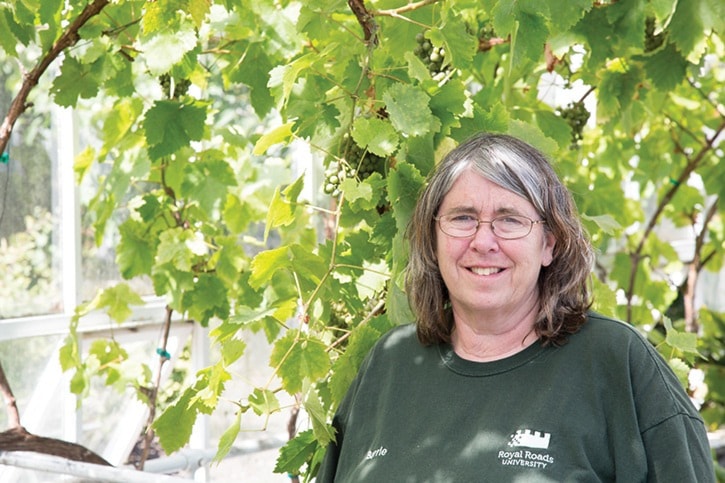Tending to the grounds at Royal Roads University requires a lot more detective work than one might think.
As a National Historic Site, Royal Roads employees are tasked with preserving as much of the site’s history as possible. While that not only includes long-term planning for the entire estate, it also means maintaining the genetics of the plants that have put down their roots for generations to enjoy.
“Every time you sink a spade in the ground you’re coming up with something,” said head gardener Barrie Agar.
While part of her mandate includes maintaining the original vistas from the castle, it also involves unearthing the motivation for why the grounds look the way they did after the Dunsmuirs were finished with them.
“We keep looking and wonder who did what and eventually I guess we’ll find out,” Agar said.
In its archives, the university has a number of the original plans for the estate, including some of the gardens. But as Agar and others have discovered, there are some discrepancies between what’s on paper and what has taken root.
 “Even they had given up on a lot of things.” Agar noted there’s some trial and error. Sometimes, she said, certain varieties just don’t last in the future due to a number of factors. Others do too well and have to be taken out before they choke out other species in the area.
“Even they had given up on a lot of things.” Agar noted there’s some trial and error. Sometimes, she said, certain varieties just don’t last in the future due to a number of factors. Others do too well and have to be taken out before they choke out other species in the area.
For example, very few of the varieties growing in the rose garden were called for in the original plan. Of the roses in the original plan, Agar said it’s almost impossible to get most of them as they no longer exist in their original forms.
Nowadays, she noted, we’ve lost a lot of varieties because new blends have been developed that have a longer cut lifespan but had to sacrifice more traditional characteristics. While they may not have been mentioned on the original plan, that doesn’t mean some of the featured varieties aren’t deeply rooted in history. A variety called Rosa Mundi was first mentioned back in 1580. A number of others date back to the 1800s.
“There’s some really beautiful roses in here,” Agar said as she points out smell and other characteristics as she passes the different blooms.
And Agar is no stranger to the intricacies of working on a historical site. While working on a big estate in Ireland, she would have to painstakingly prune every bunch of Black Hamburg grapes that grew so they would ripen evenly.
In fact, she tends to the same variety locally but doesn’t have to prune each bunch. “Who knew it would be good training for here,” she laughed. Although, she noted sometimes tending to the local grounds is a little easier than working in Ireland. Here, no one ever tells her “‘No, don’t move that, Great Uncle planted that.’”
The local vine is even grown in traditionally Edwardian fashion, with its roots planted outside and the vine trained to grow inside the glass house through an open panel. The heat is needed to ripen the grapes but the roots like cooler temperatures.
The grape vine isn’t the only piece of history in the glass house. On a tour Agar stops at a particular support, pointing to a silver scribble on the metal. She believes it references a variety of broccoli that was started inside before being transplanted in the field. It’s dated 1918.
Located inside Royal Road’s walled garden, the glass house was originally accompanied by a giant glass conservatory. It was a display garden, with a beautiful assortment of tropical plants. But keeping that structure warm in winter was no small feat. “It was something like 120 tons of coal and 200 cords of wood” to heat. Agar said owning coal businesses came in handy for James Dunsmuir when footing that heating bill.
When the military took over the estate, they turned the conservatory into a place to teach celestial navigation. Unfortunately, Agar said “in the ‘50s there was a big snow storm and it came down.” No one ever bothered to replace it, but its footprint is still there.
Also housed inside the walled garden are a number of fruit trees. “In Britain it was often the wind that would do you in,” Agar said. “Most big estates in England would have the walled gardens.”
Once it’s ripe, the fruit is harvested from those trees as part of LifeCylces’ Fruit Tree Program and donated to food banks in the region.
As an added bonus, the wall also offers a little extra protection against pests such as deer. “It’s a battle,” she said with a shake of her head. But “most of the heritage stuff that’s left has survived the deer.”
Deer are not the only creatures Agar has to contend with. The peacocks that roam the grounds, while beautiful, can also be a challenge. Adding touches such as kale to flowerbeds can often prove to be a gamble. “The first year I put it in the peacocks ate it all.”
Like the peacocks, Agar herself is a bit of a transplant at Royal Roads and landed there by sheer coincidence. “I was applying for a job teaching at Camosun,” she said when she ran into Royal Roads’ then head gardener. He encouraged her to apply for a job at the university and she has been flourishing on the grounds for 17 years.
katie@goldstreamgazette.com
